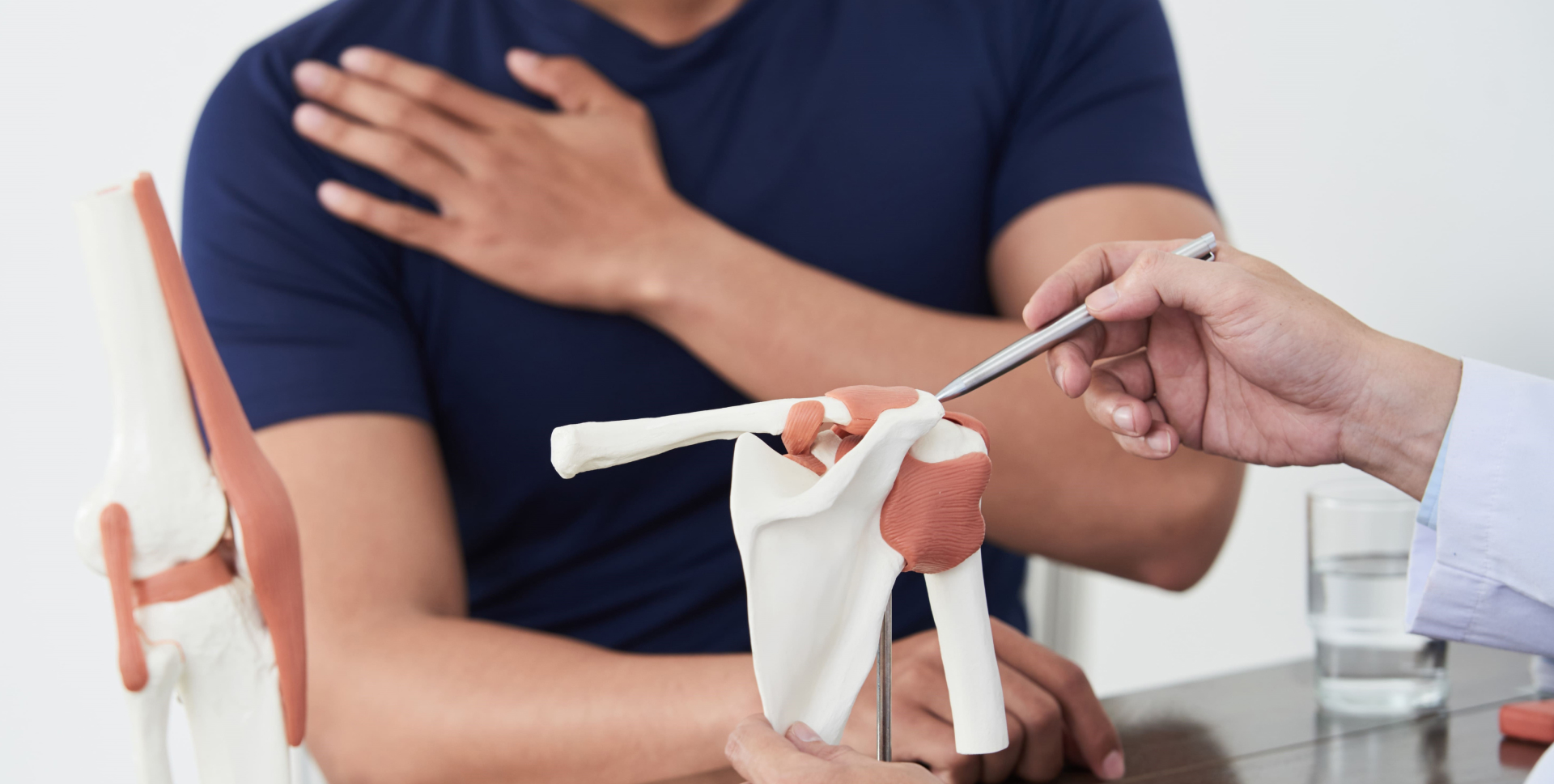Understanding Shoulder Replacement Surgery
Shoulder replacement surgery is a surgical procedure aimed at relieving pain and restoring function in severely damaged shoulder joints. It involves replacing the damaged parts of the shoulder with artificial components, known as prostheses.
The primary goal of shoulder replacement surgery is to alleviate pain that cannot be controlled by non-surgical treatments and to improve the range of motion in the shoulder.
Types of Shoulder Replacement Surgeries
Total Shoulder Replacement (TSR):
The shoulder joint’s damaged ball and socket components are replaced with prosthetic parts. This procedure is most commonly recommended for people with severe arthritis or similar conditions where both parts of the shoulder joint are affected.
Partial Shoulder Replacement (Hemiarthroplasty):
Partial shoulder replacement involves replacing only the ball portion of the joint, not the socket. This surgery is for patients with significant humeral head damage but a relatively intact socket. It’s commonly used in cases of severe fractures rather than arthritis.
Reverse Total Shoulder Replacement:
This surgery alters the positions of the shoulder’s ball and socket. It is beneficial for patients with cuff tear arthropathy. In this condition, rotator cuff tears have led to severe arthritis and shoulder dysfunction, or for those who have had previous unsuccessful shoulder surgeries.
Resurfacing Hemiarthroplasty:
This less invasive procedure involves replacing only the surface of the humeral head with a cap-like prosthesis, preserving most of the bone. It is an option for patients with localised arthritis or those who wish to maintain a more natural shoulder anatomy.
Preparing for Shoulder Replacement Surgery
Pre-operative Evaluation:
Patients must undergo a comprehensive pre-operative evaluation to assess their fitness for surgery, which includes a detailed medical history review, physical examination, and various tests to evaluate the extent of shoulder damage and plan the surgical approach.
Physical Preparation:
Patients may be advised to participate in pre-operative physical therapy, as exercises to strengthen the shoulder and arm muscles can aid in post-operative recovery.
Nutritional Considerations:
Adequate nutrition plays a vital role in healing. Patients may receive advice on optimising their diet before surgery to support recovery.
Planning for Assistance:
Recovery from shoulder replacement surgery requires assistance from friends, family, or caregivers, especially in the first few weeks. Patients should arrange for help with daily activities, such as driving, cooking, and personal care.
Pre-operative Instructions:
The surgical team will provide specific instructions to follow in the days leading up to the surgery. These may include fasting guidelines and when to stop eating or drinking before the operation.
Anesthesia Consultation:
Patients typically meet with an anesthesiologist before surgery to discuss anaesthesia options and any related risks or concerns.
The Shoulder Replacement Surgery Process
The process of shoulder replacement surgery involves several key steps, from the initial incision to the placement of the prosthetic components.
Anaesthesia:
The surgery begins with the administration of anaesthesia to ensure the patient is comfortable and pain-free throughout the procedure. General anaesthesia is commonly used.
Incision and Exposure:
The surgeon makes an incision over the shoulder to access the joint. The size and location of the incision depend on the specific type of surgery being performed.
Removal of Damaged Components:
The damaged parts of the shoulder joint are carefully removed. In a total shoulder replacement, both the head of the humerus and the surface of the glenoid are removed. In partial or hemiarthroplasty procedures, only the humeral head may be replaced.
Preparation of the Bone:
Once the damaged parts are removed, the surgeon prepares the bone surfaces to place the prosthetic components. This involves reshaping the bone to ensure a good fit with the prostheses.
Implantation of the Prosthesis:
The prosthetic components are then fitted into place.
A metal ball is attached to the humerus in a total shoulder replacement, and a plastic socket is implanted into the glenoid. In a reverse shoulder replacement, the positions of the ball and socket are reversed. The components may be fixed with cement or designed for bone to grow into them, securing them over time.
Closure:
After the prostheses are securely placed, the surgeon reattaches the muscles and tendons and closes the incision with sutures or staples. A drain may be placed to remove excess fluids from the surgical site.
Recovery in the Hospital:
Patients typically stay in the hospital for one to three days following surgery. Pain management and monitoring for any signs of complications are important during this phase.
Recovery and Rehabilitation After Shoulder Replacement Surgery
The recovery and rehabilitation phase focuses on managing pain, healing, and gradually improving shoulder function through a structured rehabilitation program.
Immediate Post-operative Care:
Pain management is a priority, with patients receiving medications to control pain in the days immediately following surgery.
Physical Therapy:
Rehabilitation begins within the first week after surgery, focusing on gentle passive exercises to maintain joint mobility. As healing progresses, active-assistive exercises are introduced to strengthen the shoulder without overstressing the healing tissues.
Home Exercises:
In addition to supervised physical therapy sessions, patients are typically given a set of exercises to perform at home. These exercises play an important role in improving strength and flexibility.
Follow-up Appointments:
Regular check-ups with the surgeon and physical therapist are necessary to monitor recovery progress and adjust the rehabilitation program as necessary. These appointments ensure that issues are promptly addressed and the patient’s recovery is on track.
The recovery and rehabilitation process duration varies among people, influenced by factors such as the patient’s overall health, the type of surgery performed, and their commitment to the rehabilitation program.
Risks and Complications of Shoulder Replacement Surgery
While shoulder replacement surgery is generally safe and effective, it does carry certain risks and potential complications. Awareness and early detection of these issues are important for prompt management to minimise their impact on the outcome of the surgery.
Infections: Infections may occur at the incision site or around the prosthetic components. Treatment for this typically involves antibiotics, but additional surgery may be required to remove or replace the implants in severe cases.
Fractures: During the surgery, there’s a risk that the bones around the shoulder may fracture. These fractures may affect the outcome of the surgery and could require additional treatments to heal properly.
Nerve and Vessel Injury: Injuries to nerves and blood vessels around the shoulder are uncommon but can happen during the operation. Such injuries may lead to temporary or permanent changes in sensation or function.
Implant Problems: Over time, the implant may become loose or wear down, especially with excessive or improper arm use. These issues can affect the longevity of the replacement and might necessitate further surgery to correct.
Conclusion
Shoulder replacement surgery represents a significant advancement in managing severe shoulder pain and dysfunction, offering patients the possibility of improved quality of life through pain relief and enhanced mobility.
The success of shoulder replacement surgery depends not solely on the surgical procedure itself but also on the patient’s commitment to recovery and rehabilitation.
Patients considering shoulder replacement surgery should thoroughly understand the procedure, including the different types of surgeries available, the preparation required, the recovery process, and the potential risks and complications.



